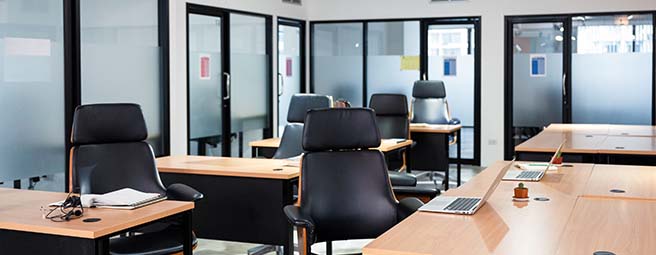
15 Tips to Make Your Office More Sustainable
Transform Your Office Into an Eco-Friendly Workspace
The environmental impact of traditional office spaces can no longer be ignored. With growing concerns about resource consumption, waste generation, and energy usage in commercial spaces, businesses are under increasing pressure to reduce their carbon footprint and implement sustainable solutions.
Creating an environmentally sustainable office space extends beyond simple recycling programs and energy-efficient lighting. From excessive energy consumption and water waste to the environmental cost of maintaining large, underutilized spaces, traditional offices often struggle to balance productivity with ecological responsibility.
Davinci Meeting Rooms addresses these challenges by offering flexible workspace solutions that significantly reduce environmental impact. By providing shared meeting spaces and fully equipped conference rooms on an as-needed basis, Davinci Meeting Rooms eliminates the waste associated with maintaining underutilized office space. Their smart building management systems, energy-efficient lighting, and commitment to digital solutions help businesses minimize their carbon footprint while maintaining professional operations.
In this comprehensive guide, we’ll explore 15 practical and effective strategies to transform your office into an eco-friendly workspace. From energy-efficient technologies and waste reduction techniques to sustainable design principles and employee engagement programs, these solutions will help you create a more sustainable office environment while potentially lowering operational costs.
Understanding Office Sustainability: The Environmental Impact
According to the U.S. Environmental Protection Agency (EPA), commercial buildings and offices account for 13% of all greenhouse gas emissions in the United States. This significant environmental footprint stems from multiple sources, making understanding the full scope of office sustainability crucial for implementing effective solutions.
The U.S. Department of Energy reports that commercial buildings consume 35% of all electricity in the United States, with lighting, heating, and cooling systems being the primary energy consumers. In traditional office spaces, approximately 30% of this energy is wasted through inefficient systems and unnecessary usage during non-operational hours.
Waste generation in office environments presents another substantial environmental challenge. The EPA estimates that the average office building generates nearly 45% of the 262 million tons of waste generated. Paper products account for approximately 70% of total office waste, with much of this being preventable through digital alternatives and better waste management practices.
The carbon footprint of traditional office spaces extends beyond direct energy consumption and waste generation. Standard office operations contribute to environmental impact through:
• Daily employee commutes
• Maintenance and cleaning operations
• IT infrastructure and electronic waste
• Single-use office supplies and materials
• Inefficient use of heating and cooling systems
• Water consumption in bathrooms and kitchen facilities
Understanding these environmental impacts is crucial as businesses seek to reduce their ecological footprint. By recognizing the various sources of environmental impact in traditional office settings, organizations can better target their sustainability efforts and make informed decisions about workspace solutions, including the adoption of flexible workspace models that inherently reduce resource consumption through shared facilities and optimized space utilization.
Rise of Sustainable Office Solutions
The evolution of sustainable office practices has transformed dramatically over the past decade, moving far beyond basic recycling programs to encompass comprehensive environmental strategies. Organizations worldwide are reimagining their workspaces to meet both environmental responsibilities and modern business needs.
Current trends in sustainable workspaces reflect this shift toward comprehensive sustainability. According to the World Green Building Council, green building practices now emphasize a holistic approach that includes energy efficiency, waste reduction, and employee wellbeing. Leading companies are implementing smart building technologies, embracing renewable energy sources, and designing spaces that minimize environmental impact while maximizing productivity.
Flexible workspaces have emerged as a particularly effective solution for businesses seeking to reduce their environmental footprint. These shared environments provide several key sustainability benefits:
• Reduced energy consumption through shared resources and optimized space utilization
• Decreased carbon emissions by eliminating the need for dedicated, underutilized spaces
• Lower resource consumption through shared amenities and facilities
• Minimized waste generation through digitized operations and shared office equipment
• Reduced commute-related emissions through strategically located facilities
As businesses continue to prioritize sustainability, the adoption of flexible workspace solutions represents a significant step toward reducing environmental impact while maintaining operational efficiency. This shift not only supports environmental goals but also offers cost savings and increased adaptability in an ever-changing business landscape.
Essential Tips for Creating an Eco-Friendly Office
Creating a sustainable office environment requires a multi-faceted approach that addresses both energy consumption and waste management. The following strategies provide a comprehensive framework for transforming traditional office spaces into environmentally responsible workplaces. By implementing these solutions systematically, organizations can significantly reduce their environmental impact while often realizing substantial cost savings.
1. Energy Efficiency Improvements
Implementing energy-efficient solutions in office spaces can significantly reduce both environmental impact and operational costs. According to the U.S. Department of Energy, LED lighting alone can reduce energy consumption by up to 75% compared to traditional lighting systems. Smart lighting systems with motion sensors and daylight harvesting capabilities can further optimize energy usage by automatically adjusting to occupancy patterns and natural light availability. Smart thermostats and HVAC optimization represent another crucial aspect of energy efficiency. Modern smart building management systems can automatically adjust temperature settings based on occupancy patterns, weather conditions, and time of day.
When selecting office equipment, look for ENERGY STAR certified devices, which use 30% to 65% less energy than standard equipment. Implement power management strategies such as:
• Configuring computers and devices to enter sleep mode after periods of inactivity
• Installing smart power strips that automatically cut power to devices in standby mode
• Scheduling regular maintenance for HVAC systems and office equipment to maintain optimal efficiency
• Using energy monitoring systems to track and optimize power consumption
2. Waste Reduction Strategies
Creating an effective waste reduction program requires a comprehensive approach that addresses multiple aspects of office operations. Implementing paperless office initiatives serves as a cornerstone of waste reduction efforts. This includes:
• Digitizing document management systems
• Implementing electronic signature solutions
• Using cloud-based collaboration tools
• Setting up digital filing systems for record-keeping
Establishing comprehensive recycling programs is essential for managing unavoidable waste. According to the EPA, effective office recycling programs can divert up to 75% of office waste from landfills. Key components include:
• Providing clearly labeled recycling bins throughout the office
• Creating designated collection points for different types of recyclable materials
• Educating employees about proper recycling practices
• Partnering with certified recycling service providers
E-waste management requires special attention due to its environmental impact. Implement responsible e-waste disposal practices by:
• Partnering with certified e-waste recyclers
• Establishing a regular schedule for electronics upgrades and disposal
• Maintaining an inventory of electronic equipment
• Considering lease options for electronic equipment to ensure proper end-of-life handling
Sustainable procurement policies form the foundation of effective waste reduction. Develop guidelines that prioritize:
• Products with minimal packaging
• Items made from recycled materials
• Supplies with environmental certifications
• Vendors with strong environmental commitments
These strategies, when implemented together, create a comprehensive approach to reducing office waste and energy consumption. Regular monitoring and adjustment of these programs ensure continued effectiveness and improvement in meeting sustainability goals.
3. Sustainable Office Design
Incorporating sustainable design principles into your office space creates an environmentally conscious environment that promotes both efficiency and employee wellbeing. Start by maximizing natural lighting through strategic window placement and open floor plans.
Select sustainable building materials that minimize environmental impact. This includes:
• Low-VOC paints and finishes to improve indoor air quality
• Recycled or renewable flooring materials
• Sustainably sourced wood products for furniture and fixtures
• Energy-efficient windows with proper insulation
Biophilic design elements connect occupants with nature while improving air quality. Consider:
• Installing living walls or indoor plants
• Creating outdoor working spaces when possible
• Using natural materials and textures
• Incorporating water features in common area
4. Resource Conservation Methods
Water conservation in office environments requires both technological solutions and behavioral changes. Install water-efficient fixtures such as:
• Low-flow faucets with automatic sensors
• Dual-flush toilets
• Smart irrigation systems for landscaping
• Water filtration systems to reduce bottled water usage
Digital collaboration tools significantly reduce resource consumption while improving productivity. Implement:
• Cloud-based document sharing platforms
• Virtual meeting solutions
• Project management software
• Digital whiteboarding tools
Sustainable office supplies play a crucial role in resource conservation. Focus on:
• Purchasing recycled paper products
• Using refillable ink cartridges
• Selecting eco-friendly cleaning supplies
• Choosing products with minimal packaging
Green cleaning products protect both the environment and employee health. Select:
• EPA-certified eco-friendly cleaning products
• Natural disinfectants
• Microfiber cleaning tools
• HEPA-filtered vacuum cleaners
These sustainable design and resource conservation methods create a comprehensive approach to environmental stewardship. Regular assessment of these initiatives ensures their effectiveness and allows for continuous improvement in meeting sustainability goals. Remember that successful implementation often requires balancing immediate needs with long-term environmental benefits, while considering both the initial investment and potential cost savings over time.
5. Employee Engagement in Sustainability
The success of any office sustainability program ultimately depends on employee participation and commitment. Effective employee engagement strategies transform environmental initiatives from top-down directives into collaborative efforts that create lasting change.
Begin by implementing comprehensive training and education programs that help employees understand the importance of sustainability and their role in achieving environmental goals. Regular workshops, lunch-and-learn sessions, and digital resources can keep sustainability practices at the forefront of daily operations.
Create incentive systems that recognize and reward sustainable behaviors. This might include:
• Monthly awards for departments with the highest recycling rates
• Recognition for employees who champion sustainable practices
• Competitions between teams for reducing energy consumption
• Incentives for using alternative transportation
Form dedicated green teams to spearhead sustainability initiatives and maintain momentum. These teams can:
• Organize environmental awareness events
• Monitor and report on sustainability progress
• Suggest improvements to existing programs
• Act as sustainability ambassadors within the organization
Track progress through measurable metrics and share results regularly with all employees. This transparency helps maintain engagement and demonstrates the tangible impact of collective efforts. When utilizing Davinci Meeting Rooms, employees can easily participate in existing sustainability programs while focusing on their core responsibilities.
Environmental Benefits of Flexible Workspaces
The shift toward flexible workspaces represents a significant advancement in sustainable office solutions, offering environmental benefits that extend far beyond traditional office settings. By their very nature, shared workspaces maximize resource efficiency through the principle of collective consumption.
Flexible workspaces demonstrate superior resource efficiency through shared amenities and infrastructure. Rather than each company maintaining separate facilities, resources such as printers, conference rooms, and catering facilities are shared among multiple users, significantly reducing the overall environmental impact per business.
Space optimization in flexible workspaces directly contributes to reduced carbon emissions. Traditional offices often maintain unused space that requires constant heating, cooling, and lighting. In contrast, flexible workspaces optimize occupancy rates, ensuring that energy is used only when and where needed. This efficient use of space can reduce a business’ carbon footprint compared to traditional office arrangements.
When compared to traditional offices, flexible workspaces demonstrate significantly lower per-person energy consumption. By sharing resources and implementing modern energy management systems, these spaces provide businesses with an immediate way to reduce their environmental impact while maintaining professional operations and meeting their workspace needs efficiently.
Making the Transition: Implementation Strategy
Transitioning to a sustainable office environment requires a strategic, phased approach. Begin with an environmental audit to identify key areas for improvement and establish baseline metrics. Create a prioritized implementation plan that balances quick wins with longer-term initiatives, considering both budget constraints and potential ROI.
Start with low-cost, high-impact changes such as implementing recycling programs and energy-efficient lighting. Gradually progress to more substantial investments in smart building systems and sustainable office equipment. Set clear timelines and measurable goals for each phase of implementation. Finally, track success through key metrics including energy consumption, waste reduction, and cost savings.
Frequently Asked Questions (FAQs)
Q1: How much money can my office save by switching to lighting?
A1: LED lighting can significantly reduce your energy bills while lasting much longer than traditional bulbs. Most businesses see a return on their LED investment within one to two years through lower electricity costs and reduced replacement needs.
Q2: What are the easiest sustainable office changes to implement immediately?
A2: The quickest changes include setting up clearly labeled recycling stations, configuring computers to enter sleep mode when inactive, and switching to digital document management systems. These changes require minimal investment while providing immediate environmental benefits and potential cost savings.
Q3: How can I get my employees excited about office sustainability initiatives?
A3: Create an engaging program that includes regular workshops, friendly competitions between departments, and recognition for sustainable behaviors. Consider forming dedicated “green teams” to champion initiatives and maintain momentum, while regularly sharing progress updates to demonstrate the impact of collective efforts.
Q4: What should I look for when choosing eco-friendly office equipment?
A4: Look for ENERGY STAR certification on all office equipment, including computers, printers, and appliances. Also consider equipment that offers power management features and the ability to track usage patterns, while prioritizing vendors who offer responsible end-of-life disposal or take-back programs.
Q5: How can flexible workspaces help my business become more sustainable?
A5: Flexible workspaces reduce environmental impact by sharing resources like printers, meeting rooms, and utilities among multiple businesses. By utilizing these spaces, you can immediately lower your carbon footprint without investing in infrastructure modifications while maintaining professional operations.
Additional Resources
Is a Virtual Office Right for Your Business?
https://www.davincivirtual.com/blog/virtual-office-right-for-your-business
How to Run a Business Without a Physical Presence [24 Tips]
https://www.davincivirtual.com/blog/how-to-run-a-business-without-a-physical-presence
Workplace Trends That Will Change How Business Is Done
https://www.davincimeetingrooms.com/blog/these-workplace-trends-will-change-how-business-is-done
9 Benefits of Flexible Business Office Space
https://www.davincimeetingrooms.com/blog/9-benefits-of-flexible-office-space-for-businesses
10 Flexible Work Space Options
https://www.davincimeetingrooms.com/blog/10-flexible-work-spaces

Categories
Subscribe to Our Blog
Archive

- April 2025
- March 2025
- February 2025
- January 2025
- December 2024
- November 2024
- October 2024
- September 2024
- August 2024
- July 2024
- June 2024
- May 2024
- April 2024
- March 2024
- February 2024
- January 2024
- December 2023
- November 2023
- October 2023
- September 2023
- August 2023
- July 2023
- June 2023
- May 2023
- April 2023
- March 2023
- February 2023
- January 2023
- December 2022
- November 2022
- October 2022
- September 2022
- August 2022
- July 2022
- June 2022
- May 2022
- April 2022
- March 2022
- February 2022
- January 2022
- December 2021
- November 2021
- October 2021
- September 2021
- August 2021
- July 2021
- June 2021
- May 2021
- April 2021
- March 2021
- February 2021
- January 2021
- December 2020
- November 2020
- October 2020
- September 2020
- August 2020
- July 2020
- June 2020
- May 2020
- April 2020
- March 2020
- February 2020
- January 2020
- December 2019
- November 2019
- October 2019
- September 2019
- August 2019
- July 2019
- June 2019
- May 2019
- April 2019
- March 2019
- February 2019
- January 2019
- December 2018
- November 2018
- October 2018
- September 2018
- August 2018
- July 2018
- June 2018
- May 2018
- April 2018
- March 2018
- February 2018
- January 2018
- December 2017
- September 2017
- June 2017
- April 2017
- October 2016
- July 2016
- May 2016
- April 2016
- February 2016
- November 2015
- September 2015
- February 2015
- January 2015
- December 2014
- November 2014
- October 2014
- August 2014
- July 2014
- July 2013
- May 2013
- February 2013
- December 2012
Talk to an expert
Want help finding the ideal meeting room? Give us a call
Book the Perfect Meeting Room Now
Find a Meeting Room








